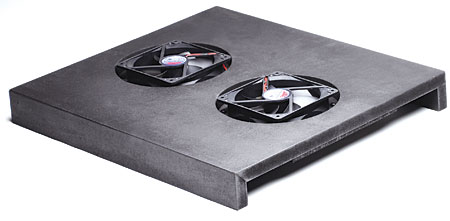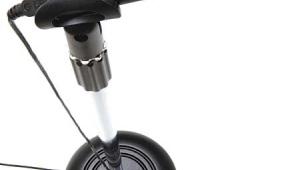So Cool
As I'm sure you've noticed by now, nearly every piece of electronic equipment you own creates heat. Some, like projectors, create a lot. Others, like DVD players, don't create very much at all. Depending on how you have your gear set up, though, any heat can create a problem. What's worse, you may not even know there's a problem until it's too late. There are solutions, though, and they vary depending on how you store your gear.
TV Stand
If you have a plasma, an LCD, or an RPTV with a stand, you probably have your gear stacked in pairs on the TV stand. If there is something on top of your receiver/amp or on top of your HD tuner or satellite or cable box, you need to move it. From personal experience, the heat that these components generate can melt the innards of equipment stacked on top. Even without gear on top, there probably isn't adequate airflow in the stand to effectively cool the equipment. Middle Atlantic makes a small disc-shaped fan called the Component Cooler. Place it over the hottest spot on your gear, and it pulls the hot air up and sends it toward the back of your rack. Check with your local Middle Atlantic representative for prices.

If you need more airflow, Active Thermal Management (ATM) has several products; which one you need depends on the size of your gear. The Cool-Sat, the Cool-Base, and the Cool-Plate have integrated fans that increase the amount of airflow through a piece of equipment. The Cool-Shelf goes between two pieces of gear and cools the lower one. These four products are $100, $240, $300, and $190, respectively.


Keep in mind that these products only aid in moving the air away from the equipment. If they're sealed into an enclosed space, they'll just move the hot air around. I'll get to moving the air out of spaces in a second.
Rack
You can use most of the cooling equipment I mentioned in the previous section in a rack situation, with the addition of one of ATM's Cool-Stack models ($325 and $650). The Cool-Stacks can either pull hot air up and out of the front of the rack or pull cool air in and blow it up through the equipment.


Equipment Room/Closet
While putting all of your equipment in an enclosed space is great for keeping the sound down, it's also great at keeping all of the heat in. Middle Atlantic's Closet Cooler, as well as ATM's Cool-Vent I, II, and III ($300 to $390), are all designed to blend in with the wood of the closet door, pull cool air in from near the floor, and blow the hot air out near the top.



Or you can dump the heat into a different room. ATM's Cool-Cube ($350) pulls hot air out of an area and through a tube to some other area (like another room, an attic, or a crawl space). Middle Atlantic's Cabinet Cooler just requires a 3-inch hole, and the fan assembly slides in, pulling the air out of the cabinet.

Computer Cooling (HTPC)
If you have an HTPC, then you understand heat on a whole other level. Worse, HTPCs tend to be extremely loud because of the number and speed of the fans in their enclosures. Water cooling is one option, and, in many situations, it can be completely silent. Keep in mind that water coolers merely move heat from the CPU or the GPU out of the case to a separate radiator. If the radiator is in the same space, you're not really doing anything to reduce the overall heat in the area.
If you want to go to the next level, CoolIT Systems uses Peltier coolers to chill the coolant before it gets to the CPU and/or GPU. The Peltier effect occurs when two different metals are connected in a certain way and an electrical current is supplied. One part gets warm, the other cool. With the CoolIT products, a heat sink and a fan then cool the warm side—very quietly.

Zalman makes heat sinks for pretty much every need. Most of them are big, quiet, and effective. Zalman got their fame from their massive copper CPU coolers. Now they make water coolers, GPU coolers, and even HTPC cases. I put one of the CNPS7700-Cu heat sinks on my blast-furnace 3.4-gigahertz Prescott CPU, and it runs quiet and cool.

In any case, you'll still have to make sure the area around your HTPC has adequate ventilation, as the heat has to go somewhere. The important thing to keep in mind when using an HTPC as a component is that, not only will it heat up the components near it (if, like I said, there isn't adequate ventilation), but the performance of the PC itself will suffer if it gets too hot. To resist damage, modern processors slow themselves down when they get too hot. So, the HTPC may seem fine, but it may be running far slower than it could. It's deceptive. The stock heat sinks might work fine in a home office or on a desk, but, when you put the computer in a rack or a closet where the ambient temperature is 20 or more degrees warmer, it's going to struggle.
Chill
Regardless of how your gear is set up, you should look into beefing up your cooling. You can implement nearly every one of the solutions I mention here with just a few tools (if tools are needed at all). Sure, cooling isn't as sexy as other upgrades, but it will definitely make your gear last longer—and keep it performing as you'd expect (or keep it performing, period). After all, melting is bad.
www.middleatlantic.com
www.activethermal.com
www.coolitsystems.com
www.zalmanusa.com
- Log in or register to post comments












































